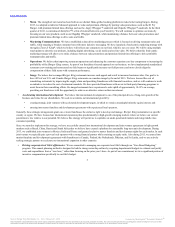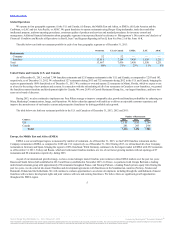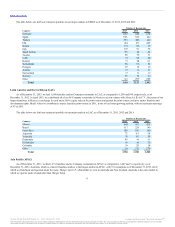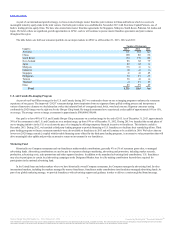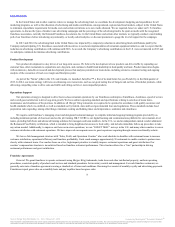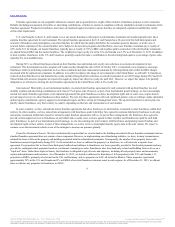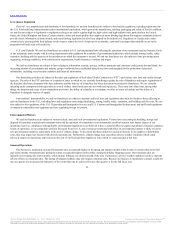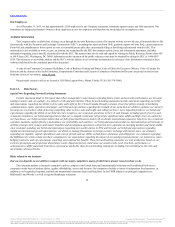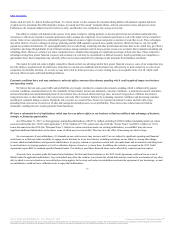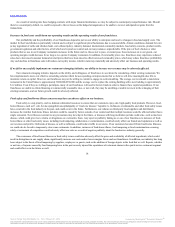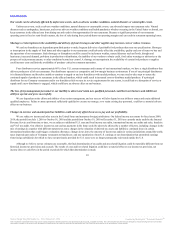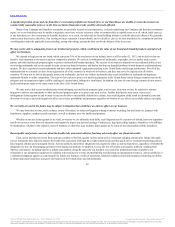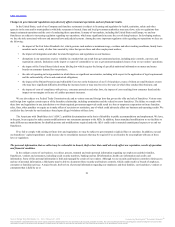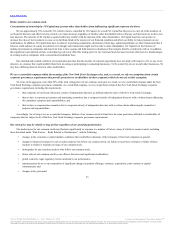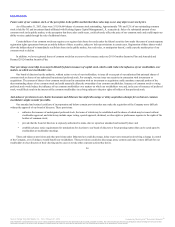Burger King 2013 Annual Report Download - page 16
Download and view the complete annual report
Please find page 16 of the 2013 Burger King annual report below. You can navigate through the pages in the report by either clicking on the pages listed below, or by using the keyword search tool below to find specific information within the annual report.
Table of Contents
Our ability to make scheduled payments on or refinance our debt obligations depends on our financial condition and operating performance, which are
subject to prevailing economic, industry and competitive conditions and to certain financial, business, legislative, regulatory and other factors beyond our
control. We may be unable to maintain a level of cash flows from operating activities sufficient to permit us to pay the principal, premium, if any, and interest
on our indebtedness. If our cash flows and capital resources are insufficient to fund our debt service obligations, we could face substantial liquidity problems
and could be forced to reduce or delay investments and capital expenditures or to dispose of material assets or operations, seek additional debt or equity capital
or restructure or refinance our indebtedness, including the Notes. We may not be able to affect any such alternative measures on commercially reasonable
terms or at all and, even if successful, those alternative actions may not allow us to meet our scheduled debt service obligations. The Senior Notes Indenture,
the Discount Notes Indenture and the 2012 Credit Agreement restrict our ability to dispose of assets and use the proceeds from those dispositions and also
restrict our ability to raise debt or equity capital to be used to repay other indebtedness when it becomes due. We may not be able to consummate those
dispositions or to obtain proceeds in an amount sufficient to meet any debt service obligations then due.
In addition, we conduct a substantial portion of our operations through our subsidiaries. Accordingly, repayment of our indebtedness is dependent on
the generation of cash flow by our subsidiaries and their ability to make such cash available to us, by dividend, debt repayment or otherwise. Our
subsidiaries do not have any obligation to pay amounts due on our indebtedness (unless they are guarantors thereof) or to make funds available for that
purpose. Our subsidiaries may not be able to, or may not be permitted to, make distributions to enable us to make payments in respect of our indebtedness.
Each subsidiary is a distinct legal entity, and, under certain circumstances, legal and contractual restrictions may limit our ability to obtain cash from our
subsidiaries. While the Senior Notes Indenture, the Discount Notes Indenture and the agreements governing certain of our other existing indebtedness limit the
ability of our subsidiaries to incur consensual restrictions on their ability to pay dividends or make other intercompany payments to us, these limitations are
subject to qualifications and exceptions. In the event that we do not receive distributions from our subsidiaries, we may be unable to make required principal
and interest payments on our indebtedness.
Approximately 100% of Burger King restaurants are owned and operated by franchisees. Our fully franchised business model presents a number of
drawbacks, such as our limited influence over franchisees and reliance on franchisees to implement major initiatives, limited ability to facilitate changes in
restaurant ownership, limitations on enforcement of franchise obligations due to bankruptcy or insolvency proceedings and inability or unwillingness of
franchisees to participate in our strategic initiatives. For example, our success in executing one of our key strategies (re-imaging our restaurant base) will
depend on the ability and willingness of our franchisees to reinvest in remodeling or rebuilding their restaurants. The problems associated with these
drawbacks may present a significant challenge for management.
A franchisee bankruptcy could have a substantial negative impact on our ability to collect payments due under such franchisee’s franchise agreements
and, if applicable, lease agreements with us. In a franchisee bankruptcy, the bankruptcy trustee may reject its franchise arrangements pursuant to
Section 365 under the United States Bankruptcy Code, in which case there would be no further royalty payments and/or rent payments from such
franchisee, and there can be no assurance as to the proceeds, if any, that may ultimately be recovered in a bankruptcy proceeding of such franchisee in
connection with a damage claim resulting from such rejection.
In connection with our refranchising strategy, we have entered into subleases with our franchisees. The subleases we enter into with franchisees for these
properties typically pass through financial obligations to the franchisee, but if a franchisee fails to perform the financial obligations passed through to them
under the sublease, we will be required to perform these obligations resulting in an increase in our leasing and operational costs and expenses.
Our principal competitors may have greater influence over their respective restaurant systems than we do because of their significantly higher percentage
of Company restaurants and/or ownership of franchisee real estate. McDonald’s and Wendy’s have a higher percentage of Company restaurants than we do,
and, as a result, they may have a greater ability to implement operational initiatives and business strategies, including their marketing and advertising
programs.
14
Source: Burger King Worldwide, Inc., 10-K, February 21, 2014 Powered by Morningstar® Document Research℠
The information contained herein may not be copied, adapted or distributed and is not warranted to be accurate, complete or timely. The user assumes all risks for any damages or losses arising from any use of this
information, except to the extent such damages or losses cannot be limited or excluded by applicable law. Past financial performance is no guarantee of future results.


